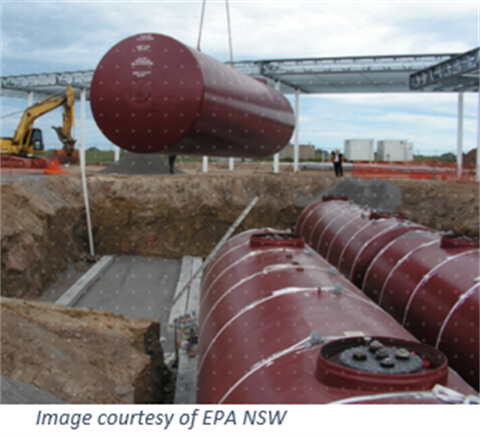Underground Petroleum Storage Systems Regulation Requirements

Under the Protection of the Environment Operations (Underground Petroleum Storage System) Regulation 2019 (“the UPSS Regulation”), the regulation of underground petroleum storage systems sites was transferred from the NSW Environment Protection Authority (EPA) to local councils. The UPSS Regulation came into force on 1 September 2019 and requires councils to enforce compliance with the UPSS Regulation for sites within their local areas.
What is an Underground Petroleum Storage System?
Underground petroleum storage systems (UPSS) are a widely used method for storing fuel beneath the ground surface at facilities such as service stations, airports, car dealerships, work depots, golf courses, and other places where fuel may be used or stored.
The UPSS Regulation
The purpose of the Protection of the Environment Operations (Underground Petroleum Storage Systems) Regulation 2019 is to ensure all UPSS are constructed, operated and maintained to prevent fuel leaks. The UPSS Regulation also requires close monitoring for fuel leaks so that they are detected and fixed early, minimising contamination.
The UPSS Regulation can be read in full on the NSW Legislation website.
Who is responsible under this legislation?
The person responsible for a UPSS is the person who has management and control of the storage system. The person responsible may be the owner of a site, a lessee, a contractor, or a company. The person responsible is legally required to ensure the UPSS complies with the UPSS Regulation.
Further information on responsible UPSS management under the UPSS Regulations is available on the EPA website.
The UPSS Regulation requires that a duly qualified person carry out certain activities such as designing, installing, modifying or decommissioning a UPSS. Any testing, repairs and ongoing maintenance of the storage system must also be undertaken by a duly qualified person.
Compliance inspections
As part of Council’s commitment to ensuring healthy environments and in accordance with the UPSS Regulation, we will be inspecting all UPSS sites to ensure compliance in order to protect the health of the environment and the public.
Council will generally contact the person responsible for the UPSS prior to a compliance inspection. However, inspections may occur without prior notice when there is a concern over the operation of the system or in response to complaints.
The NSW EPA has provided a self-evaluation compliance checklist that allows UPSS operators to review their compliance with UPSS requirements. The checklist will also be followed during inspections conducted by Council.
An inspection fee in accordance with Council’s adopted Fees and Charges may apply. The fee will be issued to the person responsible for managing the UPSS.
Forecourt management
Under the UPSS Regulation, the person responsible has a duty to maintain and manage run-off from forecourts of service stations appropriately.
The EPA has published best practice guidelines for forecourt runoff management here.
Leak Notification Requirements
The person responsible for the UPSS must immediately notify Council of a leak or spill, whether through loss monitoring of tanks and piping, inventory control, discrepancy or loss investigation, or some other method. You must complete the Leak Notification form and return to Council within 7 days when:
- A leak from a UPSS, verified in accordance with loss detection or incident management procedures that is causing or threatens material harm to human health or the environment.
- There is evidence at the site of free-phase hydrocarbons in surface water and/or groundwater.
- There is evidence that offsite migration of hydrocarbons could occur, is occurring, or has occurred.
It is against the law to allow or ignore contamination resulting from a leaking or faulty UPSS. The person responsible for the UPSS has a duty to immediately notify pollution incidents to Council.
Decommissioning of UPSS
Where a UPSS has not been used to store fuel for two or more years or where it is not intended to be used to store fuel again, it is deemed to be abandoned and must be decommissioned using industry best practice.
The person responsible for the UPSS must notify Council using the Decommissioning Notification form at least 30 days in advance prior to the decommissioning of a UPSS, or as soon as possible for an urgent or unforeseen decommissioning.
Removal of the tank is the preferred option for dealing with disused or unwanted UPSS, however depending on the site, it may be impractical or undesirable to remove some UPSS, such as those located in the basement of a building or where removal will have an impact on other structures. In these situations, the disused UPSS should be emptied and decommissioned in situ (left underground) by filling the tank with a concrete slurry, sand or foam.
SafeWork NSW must also be notified when a UPSS in a workplace is to be decommissioned.
Further information on decommissioning an underground petroleum storage tank or system is available on the EPA website.
Post-decommissioning Requirements
The person responsible for UPSS must ensure that the site is decommissioned by a suitably qualified person in accordance with EPA guidelines. The validation report for a site must be submitted to Council:
- Within 60 days of UPSS decommissioning or removal, or
- if remediation of the site is required, no later than 60 days after the remediation is completed.